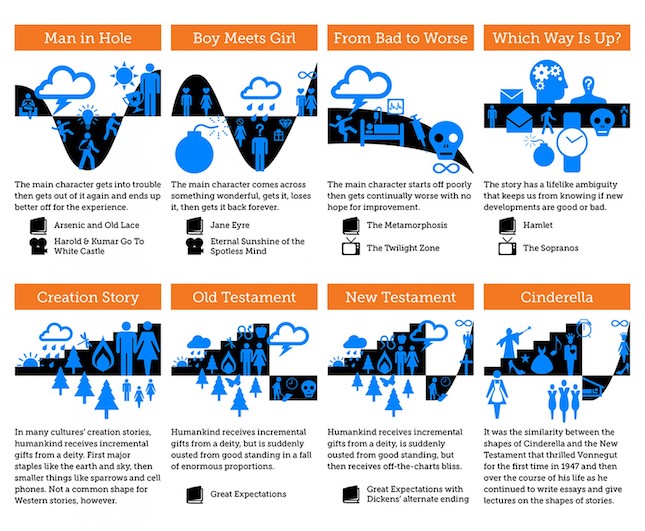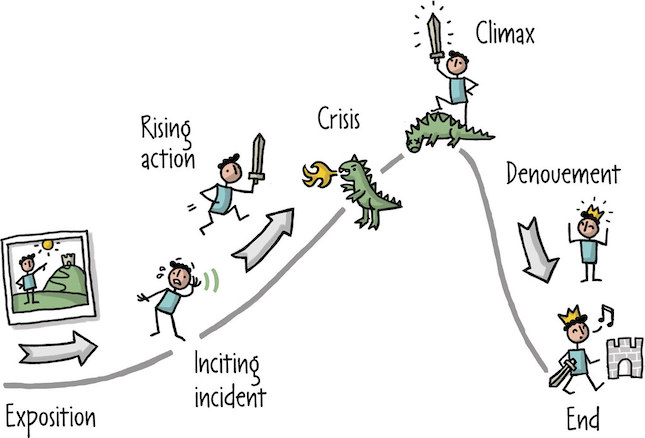What is A Story Arc?
A story arc is a movement that takes a reader through your story from the opening scene to the closing. It creates the structure of your story and the timing of events. Story arc is aligned with the plot of your story. The arc takes the reader from one state at the beginning to a changed state at the end. The arc takes your hero or heroine from an everyday beginning through conflicts and obstructions to a crisis that results in a climax followed by tying up loose ends to the last scene.
The story arc works to keep your reader engaged by leading them through conflict after conflict until a final resolution. Maintain emotional tension with highs and lows for your protagonist as your story progresses. Increase tension by creating obstacles to your protagonist’s progress that increase in difficulty until the most difficult challenge results in a final crisis.
Every Genre Needs a Story Arc
The story arc is the foundation of maintaining reader interest through increasing difficulties for your protagonist. Without an arc with ups and downs, challenges and obstacles that prevent progress, a story remains flat or, at best, is episodic with no increasing tension.
A thriller, a cozy mystery, an urban romance, an action adventure, a futuristic science fiction novel all have a story arc.
Writer Kurt Vonnegut calls story arcs the shapes of stories. He devised six different story shapes to explain how different types of stories lead a reader to the end.
 Image source Open Culture
Image source Open Culture
Here is Vonnegut diagramming several shapes.
Beginning writers can get lost in the number of story arc and story structure models available. Many course instructors have taken the basic model, renamed the parts, and sell these structure guidelines as their own.
The best way to stay clear about creating rising tension building to an exciting conclusion is to create rising and falling action in your story.
Most story arc structures are based on scholar Joseph Campbell’s The Hero’s Journey. He delineated 17 different story stages, but claimed that not all stages are in every story. The stages occur in stages according to the three-act structure.
Stages of the Hero's Journey
Act I. Departure
- The call to adventure
- Refusal of the call
- Supernatural aid
- Crossing the threshold
- Belly of the whale|
Act II. Initiation
- The road of trials
- The meeting with the goddess
- Woman as temptress
- Atonement with the father
- Apotheosis
- The ultimate boon|
Act III. Return
- Refusal of the return
- The magic flight
- Rescue from without
- The crossing of the return threshold
- Master of two worlds
- Freedom to live
How to Use A Story Arc
A story arc deepens a novel’s intensity. As a writer, you want intensity to keep your reader from putting down your book. The main idea of a story arc is to create conflicts and setbacks that rise in intensity over the course of the story.
Story Arc Writing Stage One - Planning
As you develop your story, plan scenes around the prime points of the story arc: the initial world, the turning point (crossing the threshold), the big crisis, and the climax. As you outline, the story arc helps you build in major highs and lows.
Focus on writing the story rather than attempting to hit 17 stages of a story arc. You can check for holes in the arc during editing. Choose six to eight major points and use these to develop your storyline.
The Discerning Writer suggests eight:
- Stasis - the protagonist in his everyday world
- Trigger - something unusual happens
- The quest - the protagonist takes on solving a problem
- Surprise - it’s not as easy as it first appeared
- Critical Choice - making a choice about what to do next
- Climax - confrontation with the antagonist and/or the antagonist reveals his power
- Reversal - the antagonist seems to have the upper hand
- Resolution - the protagonist overcomes the antagonist
Story Arc Writing Stage Two - Writing
Although you may have an end in mind for the story, as you are writing keep the next phase of the story arc in mind. Write each scene so it heads toward the next high or low of the story. This will keep you from rushing to the end. Going from point to point allows you to focus on each stage of the story journey.
Story Arc Writing Stage Three - First Edits
Once you’ve completed your first draft, focus your first story edit on smoothing out the progress of the entire story and filling in missing elements from the story arc.
This editing stage is especially helpful for writers who don’t plan (pantsers), to check the story arc once they have completed the story.
Bonnie Johnston, writer and editor, outlines 40 points to check in your story sequence so that scenes are grouped in sequences that form short arcs within your story.
- 1 Everyday world, everyday conflict
- 2 Setup for the inciting incident
- 3 Inciting incident
4 Aftermath of the inciting incident
5 Setup for the first complication
- 6 First complication
7 Aftermath of the first complication
8 Minor dark moment
9 Setup for the first plot point
- 10 First plot point
11 Aftermath of the first plot point
12 Second complication
13 Aftermath of the second complication
14 Setup for the first pinch point
- 15 First pinch point
16 Aftermath of the first pinch point
17 Third complication
18 Aftermath of the third complication
19 Setup for the midpoint
- 20 Midpoint
21 Aftermath of the midpoint
22 Fourth complication
- 23 Aftermath of the fourth complication
- 24 Setup for the second pinch point
- 25 Second pinch point
26 Aftermath of the second pinch point
27 Fifth complication
28 Aftermath of the fifth complication
29 Setup for the second plot point
- 30 Second plot point
- 31 Aftermath of the second plot point, part one: the dark moment
32 Aftermath of the second plot point, part two: the resurgence of hope
33 Climax, stage one: preparing for battle
- 34 Climax, stage two: taking the fight to the enemy
- 35 Climax, stage three: first contact
- 36 Climax, stage four: war of attrition
- 37 Climax, stage five: mano a mano
38 Climax, stage six: from the ashes of disaster
39 Resolution, stage one: sweeping up
- 40 Resolution, stage two: reconnection
Other story arc plans, such as Blake Snyder’s Save The Cat, originally written for screenwriters, offer alternate structure points. The idea is still the same, create and time events in your storyline to keep reader interest. Reversals and plot twists send the story in a new direction to complicate the story action.

Character Arcs
The main story arc revolves around your protagonist, but many writers create separate arcs for major characters. Creating arcs for other characters enriches your story and provides fresh ways to grab reader attention. Each character’s storyline follows a line of triumphs and setbacks with increasing difficulty.
Weave the points of character arcs into the main story and subplots to create reader engagement.
Create Your Story Arc
You can see from the varied suggestions, that the elements of the story arc are up to you. The goal of the story arc is not to jam pieces of your story into a formula, but to create a story that leads your reader on an emotional reading journey.
Your genre will dictate which parts of the arc you emphasize. And the genre suggests the types of obstacles, conflicts, triumphs, and setbacks you create in your story.
The principal point of using a story arc is to make your story interesting, emotional grabbing, and exciting to keep your reader reading.


